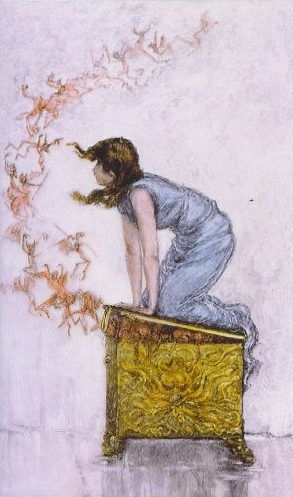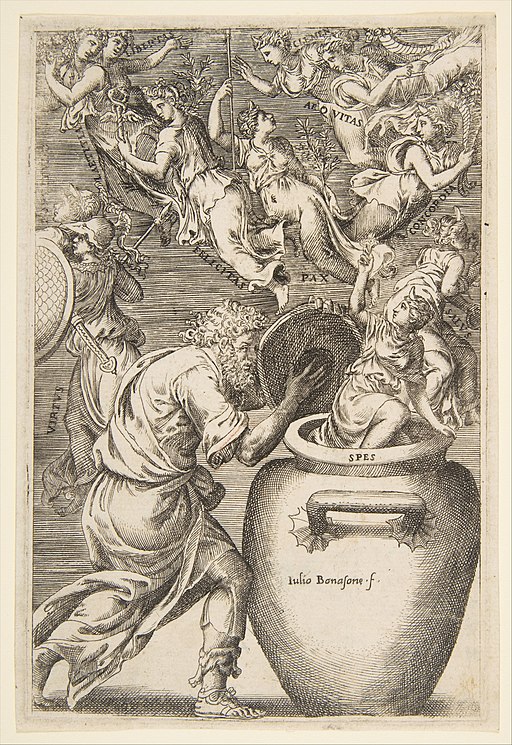
What is Pandora’s Box?
Well, it’s something of an origin story–much like the origin story of Christianity, with Adam and Eve and the Tree of Knowledge. It is said in Christianity that all of the evil that arose in the world of humans only came about after Eve ate the fruit from the Tree of Knowledge. In the older, ancient Grecian mythologies, there was Pandora’s Box which was an attempt to explain the beginning of how the world came to be as it is today. This attempt at an explanation comes from the naturally curious nature of all people who want to know why things happen the way they do and before any scientific explanation, these myths and legends were their way of coping with what they could never hope to understand.
Pandora’s Box, Adam and Eve, as well as countless myths from cultures spanning the world from the beginning of the historical record, attempt to explain why things are the way they are. There is just something so incredibly fascinating about the curiosity of one girl dooming the entire human race to the evils and terrors of the current world. That is to say that early man decided that someone was to blame for the human experience of disease, hate, and war–and that it was inherently woman’s burden to bear for the igniting the ire of the gods, for her blatant disobedience.
The Story of Pandora’s Box
The story of Pandora and the box with which she doomed the rest of humanity, comes from Ancient Greek mythology, needless to say, there have been multiple adaptations of the original story. The story focuses mostly upon Pandora, whose name means “all-giving,” and according to the story, she was the first woman on Earth. Before the humans were put on Earth, there were only the immortals, in the form of the Gods and the Titans.
Two of these Titans, Prometheus and his brother Epimetheus had fought on the Gods’ side in the war between the Titans and the Gods. Most renditions of the story say that this was due to the prophetic powers of Prometheus, which gave him the ability to foresee the downfall of the Titans. In some of the variations, these two brothers were the cousins of Zeus, who was the King of the Greek Gods.
When Zeus invested himself in creating inhabitants of the mortal realms he called upon the other immortals for their assistance. Prometheus and Hephaestus were requested to create man out of clay and water, where Epimetheus was enlisted to create the animals and gift them their individual abilities of courage, swiftness, stealth, and more. Unfortunately, Epimetheus gifted out all of the abilities before the creation of man and there were no abilities left to give to them.
In response to this lack of gifts to bestow upon his creation, Prometheus decided to give man the ability to stand upright like the immortals and much to the chagrin of Zeus, Prometheus also gave man the gift of fire. This angered Zeus greatly, as he had purposefully denied man the gift of fire, and in order to give man fire, Prometheus had to steal it from Zeus. Some believe that Prometheus stole it from Zeus through means of one of his lightning bolts, others believe it was fire from the forge of Hephaestus.
As a punishment, Zeus chained Prometheus to a giant rock far off in the Caucasus Mountains where no one would be able to find him.
Zeus tortured Prometheus daily, by sending an eagle to feast upon his liver, which would grow back in time for the next day–that is until Heracles found Prometheus, killed the eagle and freed Prometheus from his imprisonment.
Prometheus wasn’t the only one to suffer Zeus’ wrath though, instead, he aimed to punish both brothers for the missteps of Prometheus. Hephaestus was asked by Zeus to create Pandora, the first woman, out of clay and water, and modeled her after the goddess Aphrodite.
intending her to be a punishment for Epimetheus and mankind, so each god and goddess gave Pandora gift–beauty, wisdom, charm, music, curiosity, persuasion, kindness, generosity, peace, and health, some of which could be used for good and some which could be used for evil.
Zeus sent Pandora to Earth to be Epimetheus’ wife and despite Prometheus’ warning of Zeus’ two-faced nature, to not accept any gifts from the gods, Epimetheus had fallen in love with Pandora from the moment he laid eyes upon her and wanted to marry her immediately. As a wedding present, Zeus gave Pandora a box and attached to the box was a note stating that it was never to be opened, but included a key regardless.
Due to one of her many gifts from the gods and goddesses, Pandora ached to see what kind of treasures were hidden inside–eventually, her overwhelming curiosity got the better of her; when Epimetheus was out of sight, she grabbed the key and unlocked the box. Upon its opening, a plague of buzzing moths escaped from within; Pandora had thusly released horrible things. This plague of moths bestowed mankind with greed, envy, hatred, pain, disease, hunger, poverty, war, and death. All of the miseries of life had been released upon the world before Pandora was able to slam the lid of the box closed. Her guilt overtook her, and she curled up crying for what she had done, when Epimetheus came to see what was wrong she told him what she had done.
A small voice emerged from within the box, but neither of them could understand what was being said–knowing that she had already done as much damage as she could, Pandora again opened the box to show Epimetheus the box was now empty. Except, there was one moth left which flew out upon her opening the box a second time. This last moth was the embodiment of hope, and it was the only thing that allowed humans to stay positive enough to survive the wickedness that Pandora had unleashed upon the world.
The term “Pandora’s Box” now epitomizes anything that is virtually unknown, but is best left alone, for the fear of what might come from being too curious.

Georgia-based author and artist, Mary has been a horror aficionado since the mid-2000s. Originally a hobby artist and writer, she found her niche in the horror industry in late 2019 and hasn’t looked back since. Mary’s evolution into a horror expert allowed her to express herself truly for the first time in her life. Now, she prides herself on indulging in the stuff of nightmares.
Mary also moonlights as a content creator across multiple social media platforms—breaking down horror tropes on YouTube, as well as playing horror games and broadcasting live digital art sessions on Twitch.

